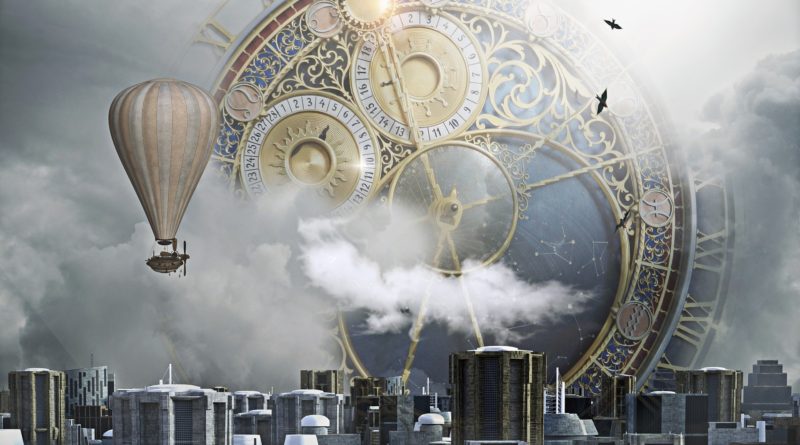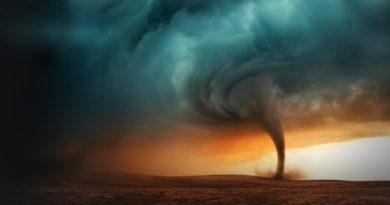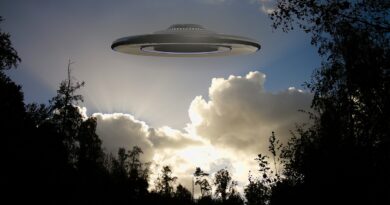The Many Ciphers of ‘Mystery, Babylon’
By S. Douglas Woodward
This is the fourth in a series of articles exploring the symbols identifying “Mystery, Babylon” from Revelation 17.
“And I stood upon the sand of the sea, and saw a beast rise up out of the sea, having seven heads and ten horns, and upon his horns ten crowns, and upon his heads the name of blasphemy.” – Revelation 13:1
“And before the throne there was a sea of glass like unto crystal: and in the midst of the throne, and round about the throne, were four beasts full of eyes before and behind.” – Revelation 4:2
“And I saw as it were a sea of glass mingled with fire: and them that had gotten the victory over the beast, and over his image, and over his mark, and over the number of his name, stand on the sea of glass, having the harps of God. – Revelation 15:2
“Then one of the seven angels who had the seven bowls came and said to me, ‘Come, I will show you the judgment of the great prostitute who is seated on many waters.’” – Revelation 17:1
“And the angel said to me, ‘The waters that you saw, where the prostitute is seated, are peoples and multitudes and nations and languages.’” – Revelation 17:15
From the Desolate Wilderness of Revelation 17 to Its Unsettled Waters

While the desert or wilderness constitutes a dominant cipher telling the meaning of Babylon, both the words for sea and for water (thalasses and hudor in Greek) are also vital symbols in the visions of John. Indeed, water and the sea play no small part in the book of Revelation.
Water comprises the symbol of eternal life – the Living Water – those who drink of it shall never thirst again (John 4:10; Jeremiah 17:13). This symbol recurs in Scripture. It plays no small part in the book of Revelation.
“For the Lamb which is in the midst of the throne shall feed them and shall lead them unto living fountains of waters: and God shall wipe away all tears from their eyes.” – Revelation 7:17
“He said to me: ‘It is done. I am the Alpha and the Omega, the Beginning and the End. To the thirsty I will give water without cost from the spring of the water of life.’” – Revelation 21:6
“Then the angel showed me the river of the water of life, as clear as crystal, flowing from the throne of God and of the Lamb down the middle of the great street of the city. On each side of the river stood the tree of life, bearing twelve crops of fruit, yielding its fruit every month. And the leaves of the tree are for the healing of the nations.” – Revelation 22:1-2
However, before the waters quench the thirst from our hearts longing to know uninterrupted peace and unconditional love, the water first represents chaos.
In these scriptures above, first from Revelation 13 and then elsewhere in John’s Apocalypse, we witness the chaos of the sea. We are told it in Revelation 17, it represents many peoples, nations, and tongues. The sea tosses to and fro, symbolizing confusion. It stirs up a great beast analogous to the iconic chaotic sea in Mesopotamian religion. And, in greatest contrast, in heaven we see a sea of glass, which bespeaks a crystal-clear calm when we stand, with John, before the throne of God (Revelation 4:6, 15:2). Just as Jesus walked on the raging sea but calmed the tempest when Peter attempted to walk on the waters to meet Him, the presence of God tames the tossing of the waves of the multitudes of clamoring peoples.
To clarify further, the sea referenced in Revelation 13:1 and verse 7 which relates to the Beast, coincides with the many waters of Revelation 17:1 and verse 15 – where the harlot sits. The many waters that the Angel deciphers for John stands as a symbol for peoples, multitudes, nations, and tongues. (Such confusion hearkens back to the Tower of Babel itself which in Hebrew means confusion, although in Aramaic it means “gate of the gods” as popular writer Thomas Horn notes.)

“And there came one of the seven angels which had the seven vials, and talked with me, saying unto me, ‘Come hither; I will shew unto thee the judgment of the great whore that sitteth upon many waters.’” – Revelation 17:1
“And he saith unto me, ‘The waters which thou sawest, where the whore sitteth, are peoples, and multitudes, and nations, and tongues.’” – Revelation 17:15
What City Is the Bridge Over Troubled Waters?

The harlot, “Mystery Babylon,” although visited by John in the wilderness, is also a woman that “sits on many waters.” While seemingly contradictory if we talk about a geographical place and time (a land of desert and a land of many waters) it is much less so if symbols are being strung together by the author, each representing a different aspect of the same city – emanating from a vision or reciting a supernatural encounter with an angel.
Since Mecca, Rome, and Jerusalem are not port cities, they would all be disqualified as the woman on the waters. However, if literal waters are not the meaning of this cipher, then none of these cities should be ruled out. In fact, since all cities have played host to “the madding crowd” in their tumultuous past, each in their own respective way represents the troubled waters of human civilization which has never known enduring peace.
John Gill (1697 – 1771) provides an extensive commentary on the usage of the sea and the waters from the chapter we are considering. While Gill, writing in the seventeenth century, assumed that “Papal Rome” comprised the woman on many waters, his explanation on how the scripture employs “waters” and the “sea” provides an insightful if not inspired exposition. Beginning with the angel who explains to John:
“The waters which thou sawest, where the whore sitteth; are peoples, and multitudes, and nations, and tongues;” denoting the vast multitude of people, of which the several kingdoms, of divers languages, consist, which belong to the jurisdiction of Rome Papal: it is an eastern way of speaking, and is particularly used to express the various kingdoms, and infinite number of people belonging to the Babylonish monarchy, which was an emblem of the antichristian state, (Daniel 3:4) and these are compared to waters, to many waters; which phrase sometimes is used for the sea, (Psalm 107:23) [“They go down to the sea in ships.”] because of the vast numbers of them; the whole world wondered after the beast, and the kings and inhabitants of the earth have been subject to the see [aka Vicar or Pope] of Rome; and because of their overbearing force, carrying all before them; (see Isaiah 8:7)…
[“Now therefore, behold, the Lord bringeth up upon them the waters of the river, strong and many, even the king of Assyria, and all his glory: and he shall come up over all his channels, and go over all his banks;”] and because, like waters, they are continually upon the flux, one generation succeeding another; and because of their instability, fickleness, and inconstancy, as in religion, so in their constitution, they will hate the whore they love; and as they frequently change and alter in their form, at last they will utterly cease: so the Jews interpret many waters, in (the Song of) Solomon 8:7, of all people, and of the kings of the earth, and of the nations of the world; and they say, that many waters never signify any other than all the nations, and those that are appointed over them. So, ‘he drew me out of many waters,’ Psalm 18:16 is by the Targum on the place explained, ‘he delivered me from many people.’ And so, Psalm 46:4 is paraphrased by the Targumist; ‘people,’ ‘as rivers,’ and their streams, shall come, and make glad the city of the Lord.”By the Waters of Babylon

But should we understand that Babylon is as a city that sits on many waters? Psalm 137, often sung in a round in modern day, testifies that it can easily be so construed.
Given the magnificent Euphrates river that runs through Babylon (and the Tigris, not that many miles away, where tradition and biblical evidence asserted that Babylon lay on the plain of Shinar (where the two rivers nearly come together)), we can rightly conclude that ancient Babylon should be considered a land that sits on many waters.
Psalm 137:1-8 comprises a hymn of lament that speaks of the Jews sitting beside the waters of the Chaldea while mourning for Jerusalem:
“By the rivers of Babylon, there we sat down, yea, we wept, when we remembered Zion.
We hanged our harps upon the willows in the midst thereof.
For there they that carried us away captive required of us a song; and they that wasted us required of us mirth, saying, Sing us one of the songs of Zion.
How shall we sing the LORD’S song in a strange land?
If I forget thee, O Jerusalem, let my right hand forget her cunning.
If I do not remember thee, let my tongue cleave to the roof of my mouth; if I prefer not Jerusalem above my chief joy.
Remember, O LORD, the children of Edom in the day of Jerusalem; who said, raise it, raise it, even to the foundation thereof.
O daughter of Babylon, who art to be destroyed; happy shall he be, that rewardeth thee as thou hast served us.”
Ezekiel, who was taken captive by King Nebuchadnezzar along with many of his countrymen in the first exile from Judah circa 597 B.C., describes his location in Babylon to be near the river Chebar, now known as the Kebar Canal near Nippur, another ancient city proximate to Babylon. It too was likely erected by Nimrod.

At the very least, the city was occupied and considered sacred since Nimrod’s time. We read in Ezekiel, “Now it came to pass in the thirtieth year, in the fourth month, in the fifth day of the month, as I was among the captives by the river of Chebar, that the heavens were opened, and I saw visions of God” (Ezekiel 1:1). Ezekiel mentions the river Chebar eight times in his book.
Almost 2,000 years before Christ, Babylon had become a land of many waters. More precisely, 1,100 years before Ezekiel’s writing, Hammurabi (c. 1810 – 1750 BC) developed extensive canals throughout the area as a means to make the land more prosperous and to strengthen his empire in Mesopotamia against many adversaries in Sumeria and Elam (this area is known in the Bible as Shinar… its name meaning “two rivers” while Mesopotamia means “between two rivers” referring of course to the Tigris and the Euphrates).
Today, Babylon in Iraq does not sit on many waters although the Euphrates remains nearby. However, when we understand that the cipher of many waters refers to vast multitudes of people dominated by an apostate woman welding false religion, the proximity and relevance of “the waters of Babylon” become much less compelling as a means to place “Mystery, Babylon” in Iraq.
Thus, either the cities of (A) Mecca or (B) Rome or (C) Papal Rome all could qualify. If we consider consumerism and secularism to embody, practically speaking, the humanist religion dominating the Western World (which we can judge chapter 18 of Revelation testifies), we can then build a case for (D) New York and London, the economic centers of the West.
The Economic Centers of the West

Nevertheless, we may rightly conclude the answer isn’t A, B, C, or D, but “all of the above.” Indeed, when we consider the following cipher in Revelation 17 which also begins with a geographical allusion, we detect that the pertinent clues coalesce around an unexpected conclusion in contrast to what most prophecy teachers in our day affirm.
Indeed, once we look past today’s teachers and study the scholarly commentary published 100 to 200 years ago (mostly in the nineteenth century) we should decide that all the cities mentioned fulfill John’s vision of “Mystery, Babylon” – with the noted exception of the historical city of Babylon on the Euphrates. Seeing it rebuilt and becoming the dominating economic, political, and military power is, as they say, “a bridge too far.” Additionally, we shouldn’t ignore the fact that since it continues to sit in a backward, unstable, and trampled down country, this hardly weighs heavily in its favor.
The lasting point we should take away, however, is that “Mystery, Babylon,” sits on many waters that consist of “peoples and multitudes and nations and languages.”
“Mystery, Babylon” remains a global phenomenon representing the chaos of the world’s system. “Mystery, Babylon’s” waters are always destined to “make waves.” John prophesies Jesus’ “Living Water” not just now with the indwelling presence of the Holy Spirit, but a yet future fulfillment when we enter our rest where waters become as smooth as glass – with no ripple to be seen from horizon to horizon.
Finally, John’s symbols consistently encourage us to think broadly, not specifically – to think globally, not just of one nation or one city. The ongoing battle rages, like the chaotic sea. The war waged constitutes the “world system” versus the “City of God” – a better city for which we, like Father Abraham, are challenged to seek. “But now they desire a better country, that is, an heavenly: wherefore God is not ashamed to be called their God: for he hath prepared for them a city” (Hebrews 11:16). Let us not so much seek the name of the city where Antichrist will reign to such an extent we fail to find the city whose name we hope to wear in the ages to come.
John quotes the words of Christ Himself, who promises that “he who overcomes will be a pillar in the temple of God, and wear on his forehead the name of God and the name of the new Jerusalem” – Revelation 3:12 (Paraphrased)

This article appeared originally on Faith Happens. Read it here: http://faith-happens.com/the-many-ciphers-locating-future-babylon-pt-3/

S. Douglas Woodward, Th.M., MA in Finance (to be completed, May 2019), is 64. He grew up in Oklahoma City, where he lives once again, after working in Boston for six years and Seattle for 21. Doug’s experience lies primarily in business information technology and financial management where he has served as an executive for Oracle, Microsoft, and a Partner at Ernst & Young LLP. He also founded his own consultancy for young companies, Smart Starters, which he managed for 10 years, before becoming Entrepreneur-in-Residence at the University of Oklahoma, Price School of Business, where he has taught classes in entrepreneurship for five years. Over the past seven years, Doug has become a nationally recognized author having written fourteen books on the topics of America’s spiritual history, eschatology, theology, and geopolitics. His books of note include The Final Babylon, Decoding Doomsday, Power Quest (Books One and Two), Lying Wonders of the Red Planet, The Revealing, The Next Great War in the Middle East, and Revising Reality. Rebooting the Bible is number fifteen. He frequently appears on radio and television programs having been interviewed on over 100 different occasions on several dozen different shows. Additionally, he speaks at conferences concerning the multiplicity of topics about which he writes. Doug has two amazing adult children, an incredible daughter-in-law, two fabulous grandsons, and a beautiful wife, Donna, with whom he celebrates over 43 years of marriage. Discover more at www.Facebook.com/sdouglaswoodward and www.faith-happens.com.



